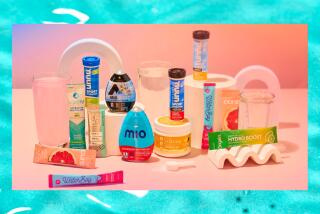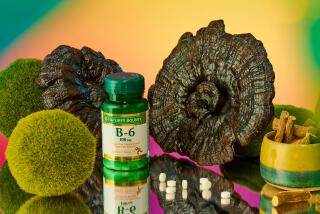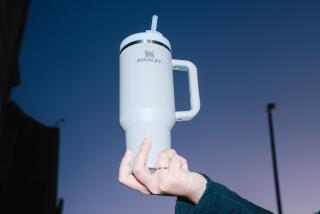Dueling Drinks : Rivals go after No. 1 Gatorade in sports beverage industry.
- Share via
Their palates are as well developed as the neck muscles bulging beneath their helmets. For when a trainer told them to drink more fluids to reduce injuries during play, the San Francisco 49ers turned up their collective noses at the traditional performance pick-me-up: Gatorade Thirst Quencher.
So, what’s a football team owner to do to keep his men injury free? If he’s Edward J. DeBartolo Jr., he’ll go out and develop a whole ‘nother sports drink for his persnickety players.
That’s exactly what happened. The year: 1986. The drink: PowerBurst.
PowerBurst hit the shelves last April after three years and $5 million spent on research and development. It is one of more than a score of contenders in the growing sports-beverage arena--that small slice of the soft drink industry focused on the fit, where fluid absorption is just as important as flavor.
Pitched by Super Bowl heroes Joe Montana and Roger Craig, produced by PowerBurst Corp. of Fresno, and designed by Vitafort International of Mill Valley, Calif., PowerBurst hopes to make it to the pros and topple top-seeded Gatorade.
Right now, that’s about as likely as the dismal Detroit Lions mowing down DeBartolo’s own Super Bowl champs. For Gatorade--that murky mixture of indiscriminate flavor--has so defined the sports drink industry that it enjoys about a 95% market share, industry watchers say.
“Gatorade is clearly the marketing success story,” says Bonnie Rivers, food industry analyst for Salomon Bros. in New York. “They’ve turned the market into something that people didn’t think it could grow into.”
When Quaker bought Gatorade from Stokely-Van Camp in 1983, Gatorade’s annual sales were about $90 million, said Quaker spokesman Ron Bottrell. Today, Bottrell said, sales have reached the $450 million mark.
What that means is that today’s sports drink market has reached a stout $475 million in annual sales. John McMillin, food industry analyst for Prudential-Bache Securities in New York, expects it to double by 1991. The reason, he says, is simple.
“People just don’t drink water anymore;they look for something more,” he said. “That’s partly what’s driving it. And I still think this industry has the potential to grow even further. There’s a lot of business to be taken away from Coke and Pepsi, as people look for something better for them. This is a business with the wind to its back.”
Growth potential is so great that on Sept. 25, Pepsi-Cola Co. got into the act with Mountain Dew Sport--a vitamin and mineral fortified, noncarbonated version of the original citrus like beverage.
Mountain Dew Sport is being test marketed in Eau Claire, Wis., said Jeff Brown, a Pepsi spokesman. There are no plans yet to roll the product out nationwide.
“Gatorade has been on the market with no significant challengers for more than 20 years,” Brown said. “Eighty percent of the people who drink soft drinks do not drink Gatorade. Of the people who do, many say they don’t like the taste. The big difference between Mountain Dew Sport and Gatorade is that Mountain Dew Sport tastes good.”
Sports beverages like Gatorade, PowerBurst, 10-K, Mountain Dew Sport and Exceed are unquestionably healthier than the likes of Coca-Cola Classic or Sprite--if only because of the higher sugar content of the carbonated drinks.
But sports drink makers say there’s much more behind their beverages than that. Not only do sports drinks quench thirst, manufacturers say, but they also replenish energy to muscles under stress during exercise. In other words, water’s not enough if you’re going to be running marathons, playing five sets of tennis or challenging Joe Montana to a game of football.
“During prolonged exercise, the body loses vital fluids and significantly depletes its carbohydrate stores,” warns a Gatorade brochure. “Consuming water alone may replace body fluids, but it will not provide critically needed energy to working muscles.”
Kind of a dire warning for the weekend athlete. But, like PowerBurst, Gatorade was first formulated with the more serious sportsman in mind. In 1965, a group of physiologists at the University of Florida concocted the original cloudy green drink as a fluid replacement beverage for the Florida Gators football team.
Stokely-Van Camp bought the rights to the concoction, and turned it into a small but healthy industry with significant strength in the Sun Belt. Then Quaker took over and ran with it.
Today, Gatorade sponsors 6,000 sporting events per year, its characteristic coolers and cups grace the sidelines of most National Football League tourneys, and every weekend athlete thinks he needs a bottle.
“What Quaker did with Gatorade is probably the success story of the century,” Rivers says. “There have been a couple of drinks that have popped up in the last year or two that have shown some regional strength, like 10-K in Louisiana, but Gatorade so dominates the category.”
10-K is manufactured by Suntory Water Group, an Atlanta-based subsidiary of beverage giant Suntory International. And Suntory found out just how serious Gatorade is about defending its territory.
In 1986, Suntory got the New Orleans Saints football team to adopt 10-K as its official beverage and display the drink in 10-K coolers a la Gatorade. 10-K still is the Saints’ official beverage, says Yasuhiro Morimura, executive vice president of the Suntory Water Group, and it can remain that way as long as company and team management get along.
But the 10-K coolers go.
For Gatorade has signed a contract with the NFL that requires all teams to have Gatorade coolers on the sidelines starting next season. What’s in those coolers, however, is up to the teams.
“Gatorade obviously is very concerned about the losing of ground,” Morimura says. “We believe that we are the first to really threaten them.”
PowerBurst hopes to be the second.
One problem faced by Gatorade wanna-bes is that they have no identity of their own, says Rivers. If they’re going to succeed, she says, they “have to figure out how to differentiate themselves from Gatorade.”
PowerBurst is trying to do that with a sort of scientific attack.
“Gatorade has some minerals, but no vitamins,” says Richard D. Strayer, PowerBurst’s chief financial officer. “We have A, C, E and B6. We have the same minerals as they do, but we also have some they don’t have, like magnesium, pantothenic acid and biotin. We have one-fourth the sodium and twice the potassium. That is an advantage.”
But Strayer says the major difference between PowerBurst and Gatorade is the so-called energy source, to use sports beverage industry argot.
“The energy component is pure crystalline fructose versus other competitive sports products, which I won’t name, with a glucose energy source,” Strayer said. Fructose “has a longer absorption time so it stays in the body longer. That’s why PowerBurst is called the Advanced Performance Beverage.”
Officials at glucose-based Gatorade beg to differ and argue that you shouldn’t fool with success.
“A study published in the June, 1989, issue of Medicine and Science in Sports and Exercise reports that consumption of a 6% fructose beverage . . . can impair exercise performance,” according to a written statement from the company.
But who did the study? Quaker Oats.
Such a tack might be construed as poor sportsmanship, but it’s definitely good marketing. Which is why PowerBurst is keeping a wary eye on its toughest rival.
“We’re not really competing against anybody,” Strayer insists. “Gatorade is the only company that I have any concern about. But this is a very strong category. Growth is very high.”
More to Read
Eat your way across L.A.
Get our weekly Tasting Notes newsletter for reviews, news and more.
You may occasionally receive promotional content from the Los Angeles Times.











